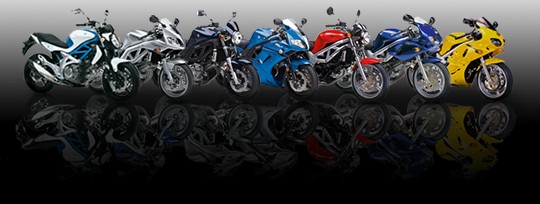 |
 |
|
|
#41 |
|
Guest
Posts: n/a
|
Two brakes and two tyres on the ground is better than one.
If you can't keep both tyres on the ground or use both brakes without locking them in an emergency, stick your L plates back on an go do some more practice, because your machine control is not of the standard required to pass a test. If your rear tyre is off the ground then the rest of your bike (the heavy bit) is free to rotate over the pivot at the front axle pin or around the pivots at the headstock or front contact patch, and you are not in control of the bike. Sent from my GT-I9300 using Tapatalk 2 Last edited by Fordward; 08-05-13 at 07:50 PM. |

|
|
|
#42 | |
|
Noisy Git
Mega Poster
Join Date: Apr 2007
Location: Halifax/Leeds
Posts: 26,645
|
Quote:
__________________
Currently Ex Biker
Now rebuilding a 63' fishing trawler as a dive boat |
|
|
|

|
|
|
#43 | |
|
Guest
Posts: n/a
|
Quote:
Any type of riding test will be failed if you lock or lift the back wheel, for good reasons of stopping distance and control. Watch any good stunt rider going from speed into a stoppie, he'll scrub off the speed with both wheels on the ground first, then once at his desired speed for the stoppie he'll increase pressure at the front and lift the rear. Sent from my GT-I9300 using Tapatalk 2 |
|

|
|
|
#44 |
|
Noisy Git
Mega Poster
Join Date: Apr 2007
Location: Halifax/Leeds
Posts: 26,645
|
Braking effort to lock = friction coefficient x reaction force.
How much braking effort can you put into the rear when it is on the verge of a stoppie?
__________________
Currently Ex Biker
Now rebuilding a 63' fishing trawler as a dive boat |
|
|

|
|
|
#45 |
|
Member
Mega Poster
Join Date: Jan 2012
Location: Basingstoke
Posts: 2,983
|
I locked the rear wheel today accidentally because it was wet. Better put my L plates back on!
__________________
MotoGoLoco - You knows it The Shed - Suzuki GSX-R 750 K1 | Triumph Tiger 1050 K6 Fallout Bikes (VLogs, Tutorials, Bike Vids) Fallout Breakbeat (My Music) |
|
|

|
|
|
#46 |
|
Guest
Posts: n/a
|
Why would you want to be on the verge of a stoppie if you want the shortest stopping distance? You've just talked about force as a result of friction co-efficient which is governed largly by contact patch size, if you have the front at 80 percent and the rear at 20 percent you have more contact with the tarmac than you would at 100 percent front on the verge of a stopppie. Both brake discs can overwhelm the tyre, its getting the best out of your two tyres that matters.
Its the principal Honda engineers used when developing linked brakes, and its long established best practice taught by any recognised training organisation you care to mention. I'm going to leave it there, I've posted what I know to be true, what anyone else whats to make of that is up to them. Sent from my GT-I9300 using Tapatalk 2 |

|
|
|
#47 |
|
Member
Mega Poster
Join Date: Jan 2012
Location: Basingstoke
Posts: 2,983
|
Not to kick up a fuss here, but if you are on the verge of pulling a stoppie, haven't you got more force pushing down into the front tyre? If so it'll be more deformed and have a larger contact patch? I wonder if MotoGP bikes have linked brakes because they're definitely not using the rear pedal when they're hanging their right foot off into corners.
__________________
MotoGoLoco - You knows it The Shed - Suzuki GSX-R 750 K1 | Triumph Tiger 1050 K6 Fallout Bikes (VLogs, Tutorials, Bike Vids) Fallout Breakbeat (My Music) |
|
|

|
|
|
#48 | |
|
Noisy Git
Mega Poster
Join Date: Apr 2007
Location: Halifax/Leeds
Posts: 26,645
|
Quote:
The verge of a stoppie IS the greatest deceleration which can be achieved. On a dry day, and even "good" wet conditions the deceleration is chassis limited and not friction limited. So actually this throws out the premise that both brakes can overwhelm the tyre. On a stock SV... the tyre can overwhelm the chassis and cause a stoppie before the tyre lets go. (unless you bang them on, but that will lock any b*stard thing) So 80/20... 80 percent of WHAT? Pedal force? Doubt it. Caliper force... measure that!... tyre torque? Contact patch force? Utilisation of grip? Bollox! So then lets go to complete geometric basics, physics 101. You did pass GCSE science right? You have a mass being acted on by a force which is below and distant from it. Lets call the "below" part the height of the center of gravity and the "behind" part half the wheelbase (for sh*t's and giggles). You slow that mass down using the contact patch, it will create a set of turning moments. Higher CoG... bigger "stoppie" moment... LowerCoG/longer wheelbase... more "keep the tyre on the floor" moment. I'll let you work out how that all slides nicely into a balance of moments equation with a couple of cos's chucked in to balance it all up nicely. F = ma right? a is what we need... a is negative in this frame of reference and is the nice thing that keeps us from sliding down the side of that bus in a heap. Bigger a = bigger F gives bigger "stoppie" turning moment. You can't escape the fact that maximum "a" is when the reaction force on the rear wheel is ZERO. Go haul an SV up for a big sodding hairpin at the end of a long straight. You will find that the traction (lol) of the rear tyre is overwhelmed JUST by the engine braking. The suspension is topped out and it's skittering like mad if you're braking anywhere near hard.
__________________
Currently Ex Biker
Now rebuilding a 63' fishing trawler as a dive boat |
|
|
|

|
|
|
#49 |
|
Guest
Posts: n/a
|
What you know to be true is actually completely false. There is no relation between friction co-efficient and contact patch size. The friction force between an object and a plane is given by Force = co-efficient of friction * weight. The co-efficient is a static number which is the same for a given material, or compound of tyre in this case.
The reason you want to stop at the verge of a stoppie is because the centre of mass of the motorcycle and rider is considerably higher the centre of rotation of the tyres. Therefore some of the stopping force is going to act to pivot the motorcycle around the front axle. The braking force can be limited by 3 things, the ability of the brake to dissipate energy, the traction available and stability of the motorcycle. When you stop on the verge of a stoppie the entire weight is on the front tyre, you have maximum traction available and you've hit the last of those. However, the only truly wrong thing you can do is stop just using the rear brake. I've never said its not possible to stop shorter with perfect use of the rear, mainly during the phase where the weight is still transferring forward but I suspect very few people can get that right in the heat of the moment and getting the front brake right is 10 times more important. |

|
|
|
#50 | |
|
Noisy Git
Mega Poster
Join Date: Apr 2007
Location: Halifax/Leeds
Posts: 26,645
|
Quote:
The coefficient of friction actually varies a bit depending on the force on the tyre, they're actually sliding a bit all the time.  And to the best of my knowledge the fulcrum point is the contact patch not the axle.
__________________
Currently Ex Biker
Now rebuilding a 63' fishing trawler as a dive boat |
|
|
|

|
 |
|
|
 Similar Threads
Similar Threads
|
||||
| Thread | Thread Starter | Forum | Replies | Last Post |
| 2 bad mistakes during todays ride, what are your thoughts? | Zorba | Bikes - Talk & Issues | 33 | 31-05-12 06:05 PM |
| My first ride...my thoughts. | piercyc87 | SV Talk, Tuning & Tweaking | 9 | 22-10-10 07:02 PM |
| Street Triple Test Ride thoughts. | DanAbnormal | Bikes - Talk & Issues | 29 | 26-04-08 08:13 AM |
| your thoughts - a long one. | Warren | Bikes - Talk & Issues | 31 | 02-02-05 01:26 AM |